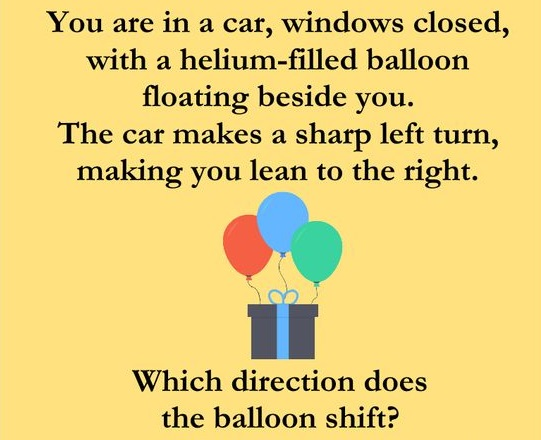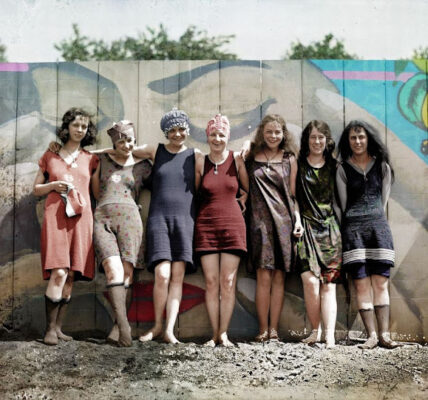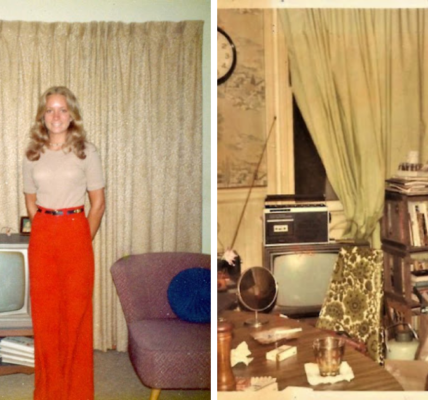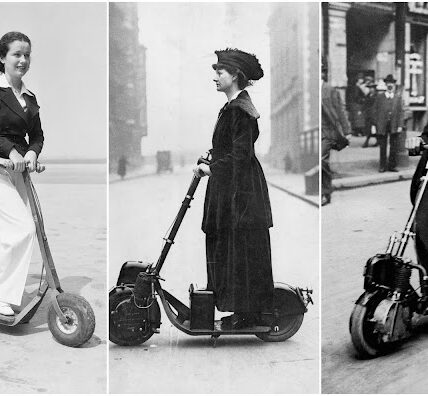Have you ever come across a puzzle that seems incredibly simple but ends up being trickier than you thought? Well, buckle up, because you’re about to dive into one such puzzle! Picture this: you’re sitting in a car, windows closed, with a helium-filled balloon floating beside you. The car suddenly makes a sharp left turn, and as expected, you lean to the right due to inertia. But here’s the puzzle—what happens to the balloon? Does it move left, right, or does it stay put?
Take a moment to think about it. Visualize the situation: you’re feeling that familiar pull to the right as the car whips around the corner. Which way do you think the balloon moves? Seems easy, right? But hold on, the answer might just surprise you.
The Common Misconception: Why Most People Get It Wrong
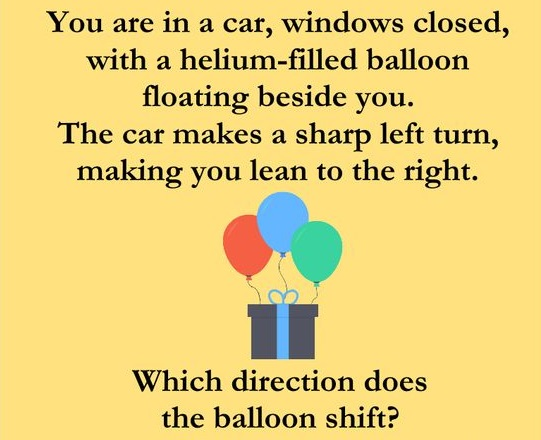
When presented with this puzzle, most people confidently guess that the balloon will move to the right. Why? Because that’s how everything else in the car behaves. You, your belongings, and the air all seem to shift right as the car turns left. It’s an instinctual response driven by inertia—one of Newton’s key principles of motion. You know, the one that says objects resist changes in their state of motion.
So, if you’re leaning to the right, it seems logical that the balloon would do the same. After all, everything else in the car appears to be reacting the same way. But here’s the twist: the balloon is not like everything else in the car. It’s filled with helium, which is lighter than air, and that crucial detail changes everything.
Understanding Inertia: Why You Lean Right
Let’s first break down what’s happening inside the car. When your vehicle makes a sharp left turn, inertia tries to push you in the opposite direction—toward the right. This is because your body wants to keep moving in a straight line, even though the car is changing direction. Everything in the car, from your phone to the air itself, feels this same force.
The heavier air molecules inside the car also experience this inertia, and they’re pushed to the right along with you. This means the air inside the car is denser on the right side, while there’s lower pressure on the left.
The Science Behind the Balloon’s Movement: It’s All About Buoyancy
Now, let’s focus on the balloon. Unlike you and the air, the balloon is filled with helium, a gas that’s much lighter than air. This is where buoyancy comes into play. Helium balloons float because they are lighter than the air around them, and they always move toward areas of lower pressure.
When the car turns left and the air is pushed to the right, the left side of the car becomes a zone of lower pressure. The helium balloon reacts to this change by moving left, toward the area of lower pressure, rather than following the rest of the car’s contents to the right.
Step-by-Step Breakdown of the Balloon Puzzle
Let’s walk through the puzzle in a step-by-step manner to fully understand why the balloon behaves differently than we might initially expect.
Step 1: Inertia at Play
When the car makes a sharp left turn, inertia pushes everything to the right. You feel it. The air feels it. Every object in the car feels it.
Step 2: Air Movement
The air molecules inside the car are heavier than helium, so they are pushed to the right side of the car during the turn. This creates a zone of lower pressure on the left side of the car.
Step 3: Balloon Reaction
Helium, being lighter than air, doesn’t behave like everything else in the car. Instead of moving to the right, the balloon floats toward the left, filling the space where the air pressure is lower.
Step 4: Final Conclusion
So, while everything else in the car—including you—leans to the right, the helium balloon moves to the left, defying the initial expectations of most people. This is because the balloon is reacting to changes in air pressure, not inertia.
Why This Puzzle Trips Up Even the Brightest Minds

The balloon puzzle is a classic example of how our instincts can lead us astray. We’re so used to thinking about how solid objects behave under inertia that we forget the impact of buoyancy. When we think of the balloon as just another object in the car, we expect it to behave like everything else. But by ignoring the fact that it’s filled with helium—a gas lighter than air—we miss the key detail that drives the correct answer.
This puzzle teaches us a valuable lesson: sometimes, the tiniest details—like the type of gas inside a balloon—can dramatically change the outcome of a situation.
The Physics Behind the Puzzle: Buoyancy vs. Inertia
Let’s dive a little deeper into the science. Inertia affects all objects inside the car, including the air. However, helium-filled balloons are subject to buoyancy, which works against the force of gravity. Helium is lighter than the air surrounding it, meaning it floats upwards and moves toward areas of lower pressure.
When the car turns left, the heavier air is pushed to the right, and the helium balloon naturally moves left into the area where the pressure is lower. This is why the balloon doesn’t follow the same rules as you or other objects inside the car. Instead, it behaves in a way that’s determined by the principles of buoyancy.
How Did You Do? The Key Takeaway from This Puzzle
So, did you guess correctly? If not, don’t worry—you’re not alone. Many people fall into the trap of assuming that everything in the car, including the balloon, will move in the same direction due to inertia. But as we’ve seen, the key difference here lies in the unique properties of helium and the balloon’s relationship to air pressure.
This puzzle is a fun reminder that when solving brain teasers, paying attention to the smallest details can make all the difference. Sometimes, things aren’t as straightforward as they seem!
Conclusion: Keep Puzzling, Keep Learning
The helium balloon puzzle shows us how easy it is to overlook crucial details when solving problems. It’s a great reminder that not everything behaves the way we expect, and sometimes the answers lie in the finer points of physics. Whether you guessed right or wrong, this puzzle hopefully stretched your thinking and sparked a little curiosity.
Next time you’re faced with a tricky puzzle, remember the lesson of the helium balloon: don’t take everything at face value—look deeper, and think critically! Keep challenging yourself with puzzles like these, and you’ll find that your problem-solving skills will only continue to sharpen.
